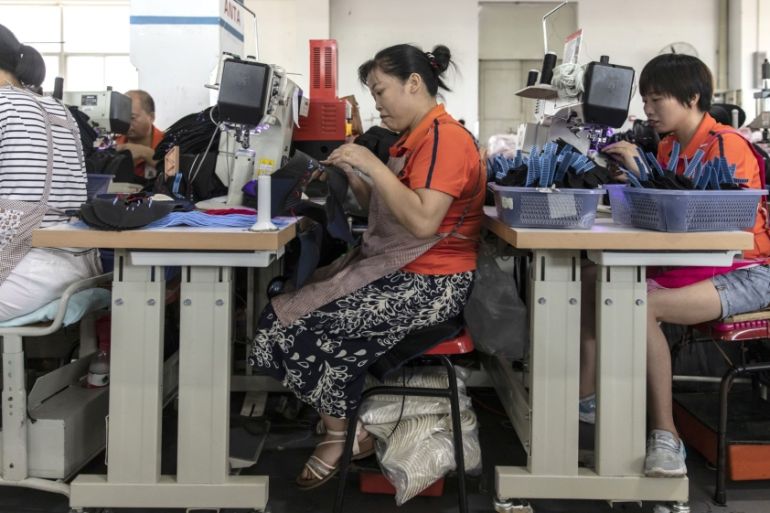Chinese factories show surprise expansion as stimulus kicks in
Output and new orders increased, but businesses remain worried over persisting US-China trade tensions.

China‘s factory activity unexpectedly expanded at the quickest pace in almost three years in November, a private business survey showed on Monday, suggesting that industries are responding to government attempts to stimulate demand.
But business confidence slipped and companies were reluctant to replenish their inventories, worried about the uncertain outlook for demand and the prolonged trade war between the United States and China.
Keep reading
list of 4 items‘We need you’: Solomon Islands’ support for US agency’s return revealed
Why are nations racing to buy weapons?
Parallel economy: How Russia is defying the West’s boycott
The Caixin/Markit Manufacturing Purchasing Managers’ Index (PMI) rose to 51.8 in November from 51.7 in the previous month with solid increases in output and new orders. That marked the fastest expansion since December 2016, when it was 51.9.
The 50-mark separates expansion from contraction on a monthly basis. Economists polled by Reuters News Agency had expected a dip to 51.4.
“The data is better than expected. It reflects that SMEs (small and medium enterprises) can access funding, and some could benefit from the uprising trend of 5G receptor manufacturing,” Iris Pang, economist for Greater China at Dutch bank ING told Al Jazeera.
Zhengsheng Zhong, director of macroeconomic analysis at CEBM Group, noted that both domestic and overseas demand rose in November.
“Manufacturing investment may be lingering near a recent bottom,” Zhang wrote in a release accompanying the data.
“If trade negotiations between China and the US can progress in the next phase and business confidence can be repaired effectively, manufacturing production and investment is likely to see a solid improvement,” he said.
China’s official factory activity gauge on Saturday also surprised, returning to growth for the first time in seven months as domestic demand picked up in response to stimulus measures. But gains were slight and export orders sluggish.
The official survey focuses more on heavy industry than Caixin’s, which is believed to include firms that are more export-oriented. The two surveys also cover different geographical areas.
Stocks ticked up across Asia on the positive data, with mainland China’s largest stocks up 0.59 percent on Monday.
MSCI’s index of Asia-Pacific shares outside Japan gained 0.46 percent while Japan’s Nikkei jumped 1.11 percent.
Shares in Hong Kong were also higher by almost 0.5 percent despite an expected slump in October retail sales data, which are due to be announced later the same day.
The Caixin survey showed that total new orders and factory production remained at buoyant levels in November, although they both eased slightly from record highs in the previous month, when they grew the fastest in more than six years and nearly three years, respectively.
Resilience in the sector led to a notable recovery in the labour market in the month, with companies adding workers for the first time in eight months.
However, profit margins remained under pressure, with input costs continuing to rise while output charges fell, suggesting some firms are still cutting their prices due to fierce competition for sales.
Trade woes
The Chinese government has been trying to spur domestic demand for well over a year, largely through higher infrastructure spending and tax cuts.
Some of this is being reflected in the latest PMI data, but the measures have otherwise been slow to gain traction as trade tensions between the US and China remain elevated.
“The official manufacturing PMI’s recovery is largely a result of (Chinese) infrastructure projects moving from investment stage to production stage, which could continue into 2020,” ING’s Pang said.
“But as tariffs are likely to persist, we expect new export orders will continue to contract on a monthly basis,” the Hong Kong-based economist added.
Although Washington and Beijing said in October they were working on a “phase one” trade agreement to ease US-China trade tensions, initial market hopes for a quick deal are fading after weeks of conflicting headlines.
A deal could slide into next year as Beijing presses for more extensive tariff rollbacks, and the Trump administration counters with heightened demands of its own.
US President Donald Trump said last week that both countries were close to an agreement. An additional 15 percent US duties on Chinese exports are set to kick in on December 15.
Meanwhile, China’s economic growth cooled to a near 30-year low of 6 percent in the third quarter and some analysts warn it could fall into the high 5 percent range in the current quarter.
To help avert a sharper slowdown, China has brought forward 1 trillion yuan ($142.07bn) of the 2020 local government special bond quota to this year. The bonds are used largely to fund public works.
China has also cut some of its key lending rates in the last few months to reduce corporate financing costs, although the reductions have been modest. Analysts believe policymakers are reluctant to unleash more aggressive stimulus out of concern it could heighten financial risks and add to a mountain of debt.